Common Ostrich
- February 29, 2024
- 0 comment
The common ostrich (Struthio camelus) is the largest living species of bird and is native to Africa. It belongs to the family Struthionidae, which is part of the order Struthioniformes. Ostriches are flightless birds, but they have large, powerful legs adapted for running. They are known for their long necks, prominent eyes, and distinctive feather patterns.

Ostriches are primarily herbivores, feeding on seeds, grasses, leaves, and occasionally insects. They are also known for their ability to run at high speeds, often reaching up to 70 kilometers per hour (43 miles per hour). Ostriches are farmed for their meat, feathers, and leather, and they are also popular attractions in zoos and wildlife parks around the world.
| Characteristic | Description |
|---|---|
| Scientific Name | Struthio camelus |
| Family | Struthionidae |
| Order | Struthioniformes |
| Native to | Africa |
| Size | Largest living species of bird |
| Weight | Up to 220 pounds (100 kilograms) for males |
| Up to 180 pounds (82 kilograms) for females | |
| Height | Up to 9 feet (2.7 meters) |
| Flight Capability | Flightless |
| Diet | Primarily herbivorous, feeding on seeds, grasses, leaves, occasionally insects |
| Speed | Can run at speeds up to 70 km/h (43 mph) |
| Lifespan | Up to 40-50 years in captivity |
| Conservation Status | Least Concern (IUCN) |
| Uses | Farmed for meat, feathers, and leather |
| Popular attractions in zoos and wildlife parks |
Exploring the Fascinating World of the Common Ostrich
The Common Ostrich, scientifically known as Struthio camelus, is a remarkable creature that inhabits the savannas and arid regions of Africa. Renowned for being the largest and heaviest living bird, the ostrich captivates with its intriguing characteristics and evolutionary adaptations.
The Common Ostrich is a flightless bird native to Africa, particularly prevalent in countries like Kenya, Tanzania, and Namibia. It belongs to the ratite family, characterized by its flat breastbone, absence of a keel, and inability to fly. Despite its flightless nature, the ostrich is a master of speed, capable of reaching remarkable velocities on land.
Physical Characteristics and Habitat
Size and Weight
The Common Ostrich holds the title of being the largest living species of bird, with adult males, referred to as cocks, towering up to 9 feet (2.7 meters) tall, while females, known as hens, are slightly smaller. Male ostriches can tip the scales at an impressive 220 pounds (100 kilograms), whereas their female counterparts typically weigh around 180 pounds (82 kilograms). Remarkably, ostrich chicks emerge from eggs that can weigh up to 1.4 kilograms (3.1 pounds).
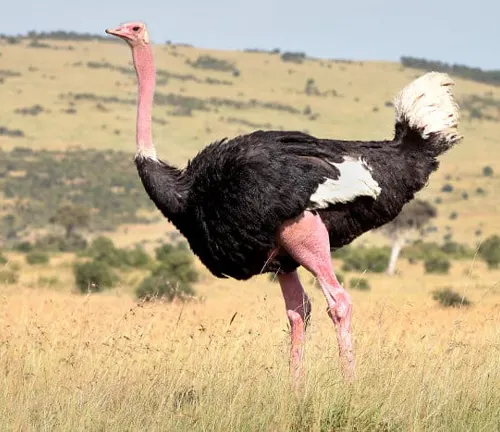
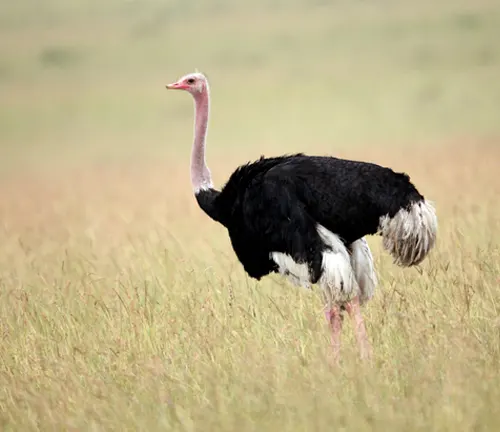
Feathers and Coloration
Ostriches boast distinctive feathers, characterized by soft, fluffy plumage covering their bodies and long, quill-like feathers adorning their wings and tails. The plumage of adult ostriches predominantly exhibits a black hue, accentuated by white plumage on the wings and tail. Moreover, the bare skin of their necks and thighs showcases a pinkish-grey coloration. Contrastingly, ostrich chicks don brownish-grey plumage adorned with white stripes, facilitating seamless blending into their surroundings and affording camouflage from potential predators. Notably, during courtship displays and moments of perceived threat, male ostriches may enhance their visual impact by fluffing up their feathers, revealing striking black and white patterns on their bodies.
Habitat and Range
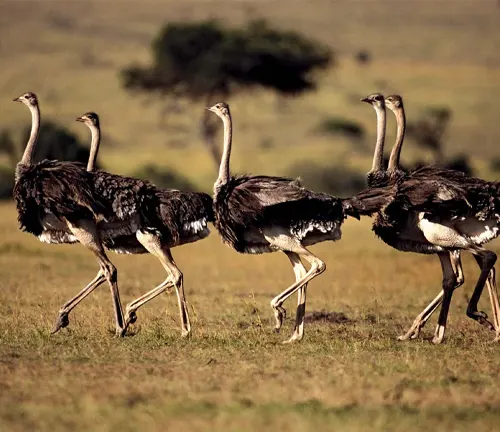
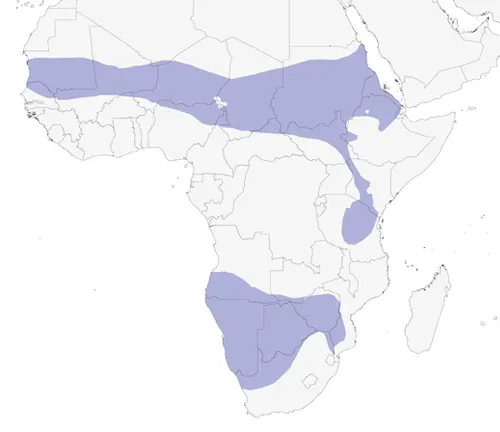
The Common Ostrich is primarily found in the open savannah and arid plains of Africa, spanning across a wide range of habitats including grasslands, shrublands, deserts, and semi-arid regions. Their distribution extends from the Sahel region of West Africa through East Africa, reaching as far south as the Kalahari Desert in southern Africa. Common Ostriches are particularly well-adapted to semi-arid and arid environments where water sources may be limited. They are known to inhabit diverse landscapes characterized by sparse vegetation and varying temperatures.
In terms of range, Common Ostriches historically inhabited a vast area of Africa, including countries such as Chad, Niger, Sudan, Kenya, Tanzania, Zambia, Zimbabwe, Botswana, Namibia, and South Africa. However, their range has been significantly reduced in some regions due to habitat loss, hunting, and human encroachment. Despite this, they are still widely distributed across sub-Saharan Africa and can be found in protected areas such as national parks, game reserves, and wildlife sanctuaries.
Behavior and Diet
Behavior
Ostriches are highly social birds, typically forming groups known as flocks, comprising several individuals. Within these flocks, a dominant male, often referred to as the alpha male, asserts control over breeding rights and territory. These birds are renowned for their intricate courtship displays, wherein males showcase a repertoire of dances and vocalizations to attract potential mates. Remarkably, when faced with threats, ostriches unleash a formidable defense mechanism: they can sprint at speeds reaching up to 70 kilometers per hour (43 miles per hour), utilizing their robust legs to administer swift kicks if necessary.


Diet
Common Ostriches primarily subsist on a herbivorous diet, encompassing a diverse array of vegetation such as grasses, seeds, leaves, flowers, and roots. They exhibit opportunistic feeding behavior, adapting their dietary preferences to the seasonal availability of food within their habitat. Additionally, ostriches supplement their diet by ingesting small stones and pebbles, aiding in digestion by grinding food particles in their gizzard. Despite their substantial size and voracious appetite, ostriches demonstrate remarkable adaptability, thriving even in regions where food resources are scarce, owing to their efficient foraging strategies and ability to extract nutrients from a wide spectrum of vegetation.
Social Structure
Common Ostriches exhibit a structured social organization, typically forming groups known as flocks, which vary in size and composition. These flocks encompass a mix of males, females, and juveniles, with a dominant male, often referred to as the alpha male, assuming leadership roles. The alpha male exerts control over the flock, particularly in matters concerning breeding rights and territorial defense. While female ostriches, or hens, may establish a pecking order within the flock, dominance hierarchies among females tend to be less pronounced compared to males. The alpha male plays a pivotal role in maintaining order within the flock, resolving conflicts, and directing group activities such as foraging and mating. Communication within the flock occurs through various vocalizations, body postures, and displays, facilitating the establishment of social bonds and coordination of group movements. While ostriches primarily display social behavior within their own species, interactions with other animals in their habitat, including symbiotic relationships and competitive interactions with predators or rivals, also shape their social dynamics.
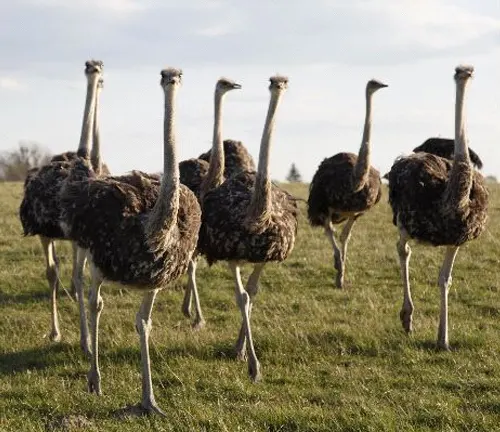
Feeding Habits
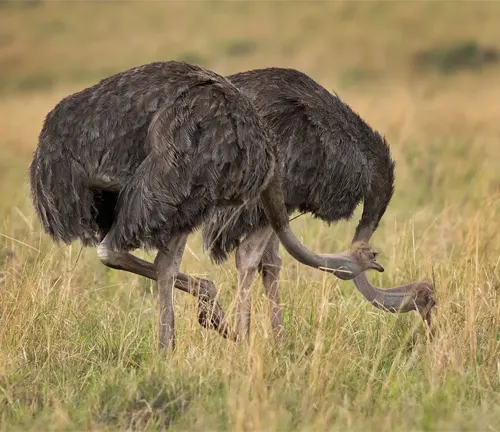
Common Ostriches exhibit a primarily herbivorous diet, marked by adaptable feeding habits suited to their environment. Their menu consists predominantly of vegetation, encompassing grasses, seeds, leaves, flowers, and roots, rendering them opportunistic feeders capable of adjusting their diet to seasonal changes and resource availability. Notably, ostriches display a remarkable ability to consume whatever plant matter is accessible in their habitat, demonstrating flexibility in their feeding behavior. Additionally, they engage in gastrolith ingestion, swallowing small stones and pebbles that aid in grinding food in their gizzard, facilitating digestion.
Despite their substantial size and voracious appetite, ostriches demonstrate efficiency in foraging, adept at extracting nutrients from a diverse array of vegetation. Their feeding habits are influenced by various factors including habitat type, climate, and food availability, enabling them to thrive across a range of environments from savannahs to semi-arid regions. While their diet primarily comprises plant material, ostriches may opportunistically consume insects or small animals, particularly during periods of food scarcity or as a supplementary source of nutrition. This adaptability and resourcefulness in obtaining nutrients contribute to the survival and ecological success of Common Ostriches in their natural habitats.
Reproduction and Nesting
During the breeding season, dominant males attract females through elaborate courtship displays involving dancing and vocalizations. Females lay their eggs in communal nests, which are carefully guarded by the dominant male. Incubation duties are shared among the females, with each taking turns to ensure the eggs hatch successfully.


Reproduction in Common Ostriches (Struthio camelus) involves complex courtship rituals and communal nesting practices:
- Courtship Displays: During the breeding season, typically in cooler months, male ostriches engage in elaborate displays to attract females. These displays include intricate dances, puffing up of feathers, and emitting low-frequency booming calls.
- Nesting Behavior: Females select suitable nesting sites within the flock’s territory, often shallow depressions in the ground lined with vegetation and surrounded by ostrich dung for protection. Common Ostriches exhibit communal nesting, with multiple females laying eggs in the same nest, known as a scrape.
- Clutch Size: Communal nests may contain up to 60 eggs, though the average clutch size ranges from 15 to 30 eggs.
- Incubation: After egg-laying, females take turns incubating the eggs, with the dominant female incubating at night and subordinate females during the day. Incubation lasts approximately 42 to 46 days.
- Hatching: Eggs hatch asynchronously over several days, allowing for staggered emergence of chicks. This reduces competition for food and parental care.
- Chick Development: Common Ostrich chicks are precocial, born with open eyes and capable of walking and feeding shortly after hatching. They remain with their parents for several months, receiving protection and guidance until they become independent.
Adaptations for Survival
Speed and Defense Mechanisms
The Common Ostrich is renowned for its incredible speed, capable of sprinting at speeds of up to 45 miles per hour. This remarkable agility serves as a primary defense mechanism against predators such as lions and hyenas.
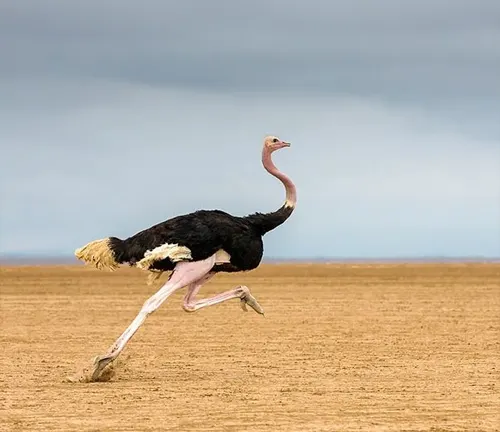

- Speed: When threatened, ostriches can sprint at speeds of up to 70 kilometers per hour (43 miles per hour), utilizing their powerful legs to evade predators. This extraordinary speed enables them to outrun many potential threats in their habitat.
- Kicking Defense: Ostriches possess strong legs armed with sharp claws, which they use as formidable weapons against predators. When cornered or threatened, they deliver swift and powerful kicks, capable of inflicting serious injury or even death to attackers.
- Camouflage: Despite their large size, ostriches have evolved effective camouflage mechanisms to blend into their surroundings and avoid detection by predators. Their cryptic plumage and ability to crouch low to the ground help them remain inconspicuous in their natural habitat.
Environmental Adaptations
In addition to their speed, ostriches have evolved various adaptations to survive in their harsh environment. Their keen eyesight enables them to detect predators from afar, while their long legs help them cover vast distances in search of food and water.
- Heat Tolerance: Ostriches are well-adapted to withstand high temperatures prevalent in their arid and semi-arid habitats. They have specialized respiratory systems and nasal passages that help regulate body temperature and conserve water.
- Water Conservation: In regions where water sources may be scarce, ostriches have evolved efficient mechanisms for water conservation. They can extract moisture from the vegetation they consume and produce highly concentrated urine to minimize water loss.
- Foraging Strategies: Ostriches are opportunistic feeders, capable of adapting their diet to seasonal changes and food availability. Their ability to consume a wide variety of vegetation allows them to exploit diverse food sources in their environment.
- Nesting Practices: Communal nesting and cooperative incubation strategies employed by ostriches help mitigate risks associated with predation and environmental factors. By sharing nesting duties and coordinating care for offspring, ostriches increase the chances of survival for their young.
Interactions with Humans
Domestication
- Ostriches have been domesticated for centuries, primarily for their valuable feathers, meat, and leather.
- Domestication efforts began in ancient civilizations like Egypt and have continued to modern times, with commercial ostrich farming operations established worldwide.
- Selective breeding programs have been developed to improve desirable traits such as feather quality, meat yield, and leather texture.
- Ostrich farming involves breeding, raising, and managing ostriches in captivity for commercial purposes.
Economic Importance
- Feathers: Ostrich feathers are highly sought after for their softness, durability, and decorative appeal. They are utilized in fashion, crafts, and accessories, contributing to industries such as millinery, costume design, and interior decoration.
- Meat: Ostrich meat is recognized for its leanness, tenderness, and nutritional value. It is marketed as a healthy alternative to traditional meats due to its low fat content and high protein levels. The ostrich meat industry provides opportunities for meat production, processing, and distribution, catering to consumers seeking healthier dietary options.
- Leather: Ostrich skin yields high-quality leather known for its distinctive texture, strength, and luxury appeal. Ostrich leather is used in the production of premium leather goods, including handbags, wallets, belts, and footwear. The ostrich leather industry contributes to the fashion and luxury goods sectors, generating revenue through the sale of upscale products.
- Tourism and Recreation: Ostrich farms and wildlife parks that feature ostriches attract tourists and visitors seeking unique experiences. Tourists often participate in guided tours, ostrich races, and interactive encounters with ostriches, contributing to local tourism economies through entrance fees, merchandise sales, and related services.
- Agricultural Diversification: Ostrich farming provides an opportunity for agricultural diversification in regions where traditional livestock farming may be less feasible. Ostrich farming operations create employment opportunities, stimulate rural economies, and enhance agricultural sustainability through alternative livestock management practices.
- Research and Conservation: Ostriches serve as subjects for scientific research aimed at understanding various aspects of avian biology, physiology, and behavior. Additionally, commercial ostrich farming contributes to the conservation of wild ostrich populations by reducing pressure on natural habitats and supporting captive breeding programs for species conservation.
Different Species
Somali Ostrich
(Struthio molybdophanes)
Found in eastern Africa, primarily in Somalia, Ethiopia, and northern Kenya. It is sometimes considered a subspecies of the Common Ostrich (Struthio camelus), but some authorities classify it as a separate species.
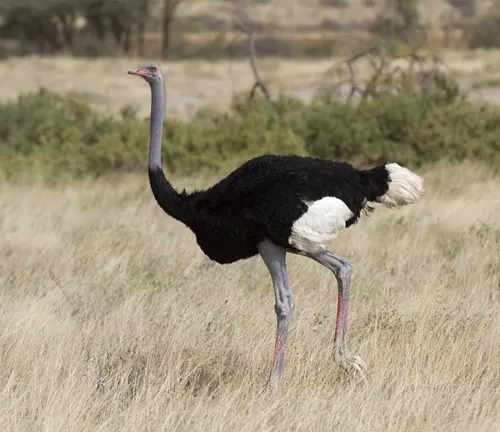
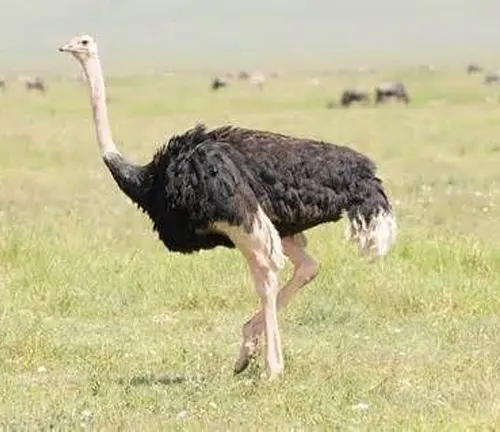
Arabian Ostrich
(Struthio camelus syriacus)
This species was native to the Arabian Peninsula but is now extinct. It was smaller than the Common Ostrich and had distinct features, including shorter legs.
North African Ostrich
(Struthio camelus camelus)
This subspecies of the Common Ostrich is found in North Africa, including countries like Egypt, Libya, and Sudan.
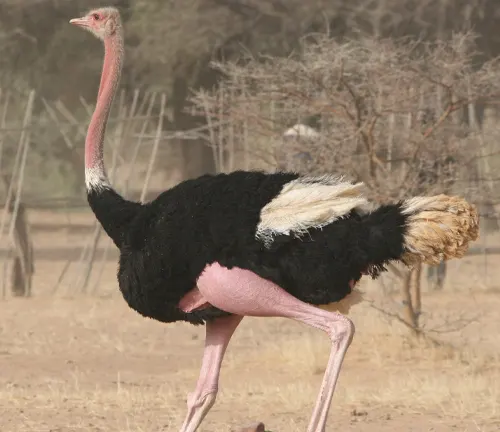
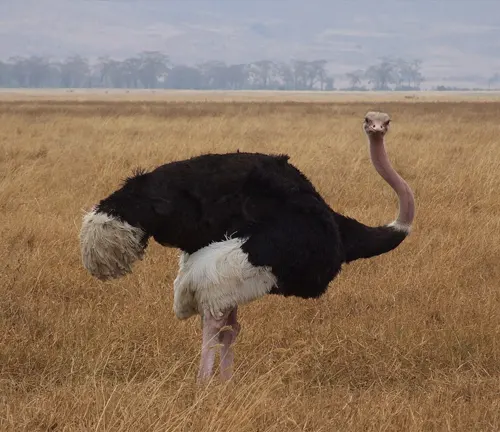
Masai Ostrich
(Struthio camelus massaicus)
Found in East Africa, particularly in Kenya and Tanzania. It is a subspecies of the Common Ostrich.
Frequently Asked Questions (FAQs)
- What is a Common Ostrich?
This question seeks a basic definition and description of the Common Ostrich, including its scientific name, characteristics, and habitat. - Where do Common Ostriches live?
This question explores the natural habitat and geographical distribution of Common Ostriches, typically focusing on Africa. - What do Common Ostriches eat?
This question addresses the diet of Common Ostriches, including their primary food sources such as plants, seeds, and insects. - How fast can Common Ostriches run?
This question pertains to the remarkable speed of Common Ostriches, which are known for their ability to run at high speeds to evade predators. - Are Common Ostriches endangered?
This question delves into the conservation status of Common Ostriches, typically highlighting whether they are threatened or endangered according to the IUCN Red List. - Can Common Ostriches fly?
This question clarifies the flightless nature of Common Ostriches and explores their adaptations for running rather than flying. - What are the uses of Common Ostriches to humans?
This question discusses the various ways in which humans utilize Common Ostriches, such as for meat, feathers, leather, and tourism. - How do Common Ostriches reproduce?
This question explores the mating behavior, reproductive biology, and nesting habits of Common Ostriches, including the role of males and females in incubating eggs. - Do Common Ostriches have predators?
This question examines the natural predators of Common Ostriches in the wild and their strategies for avoiding predation. - Can Common Ostriches be kept as pets?
This question addresses the feasibility and legality of keeping Common Ostriches as pets, including considerations for their care and habitat requirements.





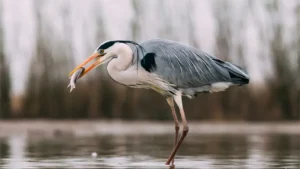
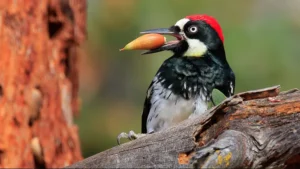

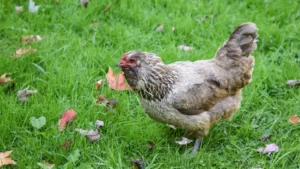

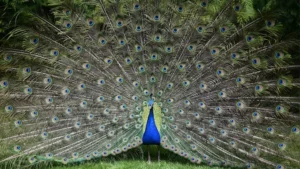



Leave your comment